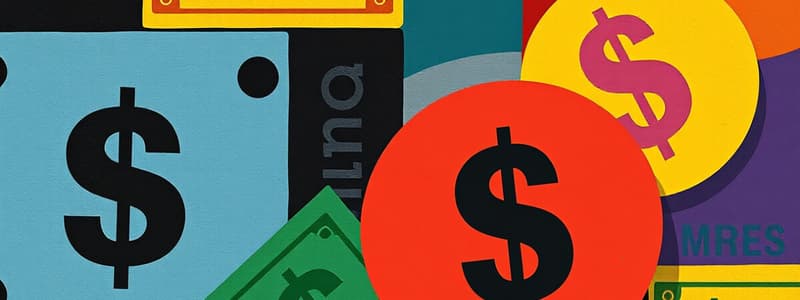Podcast
Questions and Answers
What is a key characteristic of fixed payment loans?
What is a key characteristic of fixed payment loans?
- They are repaid in fixed monthly instalments. (correct)
- They have no interest charges.
- They offer flexible repayment schedules.
- They are always secured by an asset.
Which of the following is NOT a type of revolving credit?
Which of the following is NOT a type of revolving credit?
- Overdrafts
- Credit cards
- Lines of credit
- Home mortgage loans (correct)
What typically secures a home loan?
What typically secures a home loan?
- The property acquired with the loan (correct)
- Personal assets of the borrower
- Future income potential of the borrower
- Credit history of the borrower
Inappropriate use of credit cards often results in what financial behavior?
Inappropriate use of credit cards often results in what financial behavior?
What distinguishes personal loans from home loans?
What distinguishes personal loans from home loans?
What was the original loan amount when the apartment was purchased?
What was the original loan amount when the apartment was purchased?
What is the current standard variable rate being paid on the mortgage?
What is the current standard variable rate being paid on the mortgage?
What is the loan-to-value ratio (LVR) of the original mortgage?
What is the loan-to-value ratio (LVR) of the original mortgage?
How much are the current monthly payments on the mortgage?
How much are the current monthly payments on the mortgage?
What factor should be considered when reviewing a mortgage for refinancing?
What factor should be considered when reviewing a mortgage for refinancing?
What type of assets is generally considered a sound strategy to borrow against for potential capital gain?
What type of assets is generally considered a sound strategy to borrow against for potential capital gain?
What is the typical percentage of disposable income that a home mortgage loan can take up?
What is the typical percentage of disposable income that a home mortgage loan can take up?
Paying off non-deductible debt is considered a low-risk strategy with a relatively high effective return because it saves on what?
Paying off non-deductible debt is considered a low-risk strategy with a relatively high effective return because it saves on what?
What rate of return would be required to better the return from paying off a mortgage at 6% per annum for someone in the top tax bracket?
What rate of return would be required to better the return from paying off a mortgage at 6% per annum for someone in the top tax bracket?
Which of these is NOT considered a non-investment appreciating asset for borrowing purposes?
Which of these is NOT considered a non-investment appreciating asset for borrowing purposes?
The primary benefit derived from saving on outgoings by paying off non-deductible debt is often not appreciated due to its nature of being what?
The primary benefit derived from saving on outgoings by paying off non-deductible debt is often not appreciated due to its nature of being what?
What is the expectation when borrowing to fund investments in appreciating assets?
What is the expectation when borrowing to fund investments in appreciating assets?
Which statement best describes the relationship between paying off non-deductible debt and investment income taxation?
Which statement best describes the relationship between paying off non-deductible debt and investment income taxation?
What is the monthly saving achieved by refinancing in the example provided?
What is the monthly saving achieved by refinancing in the example provided?
What is a potential downside of refinancing mentioned in the content?
What is a potential downside of refinancing mentioned in the content?
Which of the following can lead to an unfavorable financial outcome despite appearing to be a good deal?
Which of the following can lead to an unfavorable financial outcome despite appearing to be a good deal?
What is a recommendation to counteract paying more interest when refinancing?
What is a recommendation to counteract paying more interest when refinancing?
What should borrowers be cautious of when considering low-interest offers?
What should borrowers be cautious of when considering low-interest offers?
What is the correct formula to calculate taxable income?
What is the correct formula to calculate taxable income?
Which component is NOT included in taxable income calculation for the individual earning a gross salary of $125,000?
Which component is NOT included in taxable income calculation for the individual earning a gross salary of $125,000?
What is the tax-free threshold for income tax in Australia?
What is the tax-free threshold for income tax in Australia?
Which statement is true regarding the Low Income Tax Offset (LITO)?
Which statement is true regarding the Low Income Tax Offset (LITO)?
For taxpayers earning up to which income level is the maximum reduction of $700 applicable under LITO?
For taxpayers earning up to which income level is the maximum reduction of $700 applicable under LITO?
What is the Medicare Levy charged on income above $29,033?
What is the Medicare Levy charged on income above $29,033?
Which income contributes to the calculation of taxable income?
Which income contributes to the calculation of taxable income?
What is the total tax payable for an individual with a taxable income of $109,325?
What is the total tax payable for an individual with a taxable income of $109,325?
Flashcards are hidden until you start studying
Study Notes
Understanding Credit and Debt
- Credit should be secured prior to incurring any debt.
- Two main types of credit:
- Fixed Payment Loans: Includes personal loans, car loans, Buy Now Pay Later, and home mortgage loans.
- Revolving Credit: Includes credit cards, overdrafts, and lines of credit.
- Upon receipt of credit, it becomes the borrower’s debt.
Common Types of Personal Debt
-
Personal Loans:
- Funds individual purchases (e.g., cars).
- Can be secured or unsecured, with varying terms.
- Require fixed monthly payments of principal and interest.
-
Home Loans:
- Financing for buying real estate; secured by the property itself (mortgage).
- Terms range between 10 to 30 years, with repayments of principal and interest.
-
Credit Cards:
- Various types available (branded, store cards, etc.) with generally high interest rates.
- Use can encourage overspending and excessive consumption.
Funding Assets
- Debt isn’t solely for consumption; funds can also be used for appreciating assets:
- Non-investment appreciating assets (e.g., homes, vintage cars) can provide capital gains.
- Investment funding aims for returns that cover borrowing costs, yielding positive net returns.
Paying Off Non-Deductible Debt
- Mortgage repayments can consume 20-40% of disposable income, causing financial strain.
- Paying off non-deductible debt (like home loans) offers a low-risk investment return through interest savings.
- The effective return from paying off a mortgage can exceed potential investment returns after tax considerations.
Refinancing and Debt Consolidation
- Review existing mortgage interest rates to consider refinancing options.
- Example: Original mortgage of $308,000 at 5.88% with a monthly payment of $1,962; property value increased to $517,500.
- New mortgage terms at a 4.69% interest rate could lower total monthly payments significantly.
Credit Traps
- Borrowers must be cautious of hidden costs associated with seemingly attractive credit offers (e.g., '0% interest' deals).
- Common pitfalls include:
- Hidden fees and upfront charges that negate benefits of low interest.
- Dependency on payment discipline with credit cards offering interest-free periods.
Taxation Overview
- The Medicare Levy is 2% on incomes over $29,033.
- Taxable income is calculated as assessable income minus allowable deductions.
Income Tax Calculation Example
- Example of an individual earning a gross salary of $125,000 with relevant deductions results in taxable income of $109,325.
- Tax payable is calculated based on the marginal tax rate, leading to a total tax of $25,772.
- Tax-free threshold is $18,200; LITO reduces tax for incomes up to $66,667.
Taxation of Investment Income
- Investment returns (interest, dividends) are taxable income.
- Tax payable is contingent on the investor’s marginal tax rate.
Studying That Suits You
Use AI to generate personalized quizzes and flashcards to suit your learning preferences.




